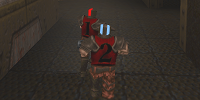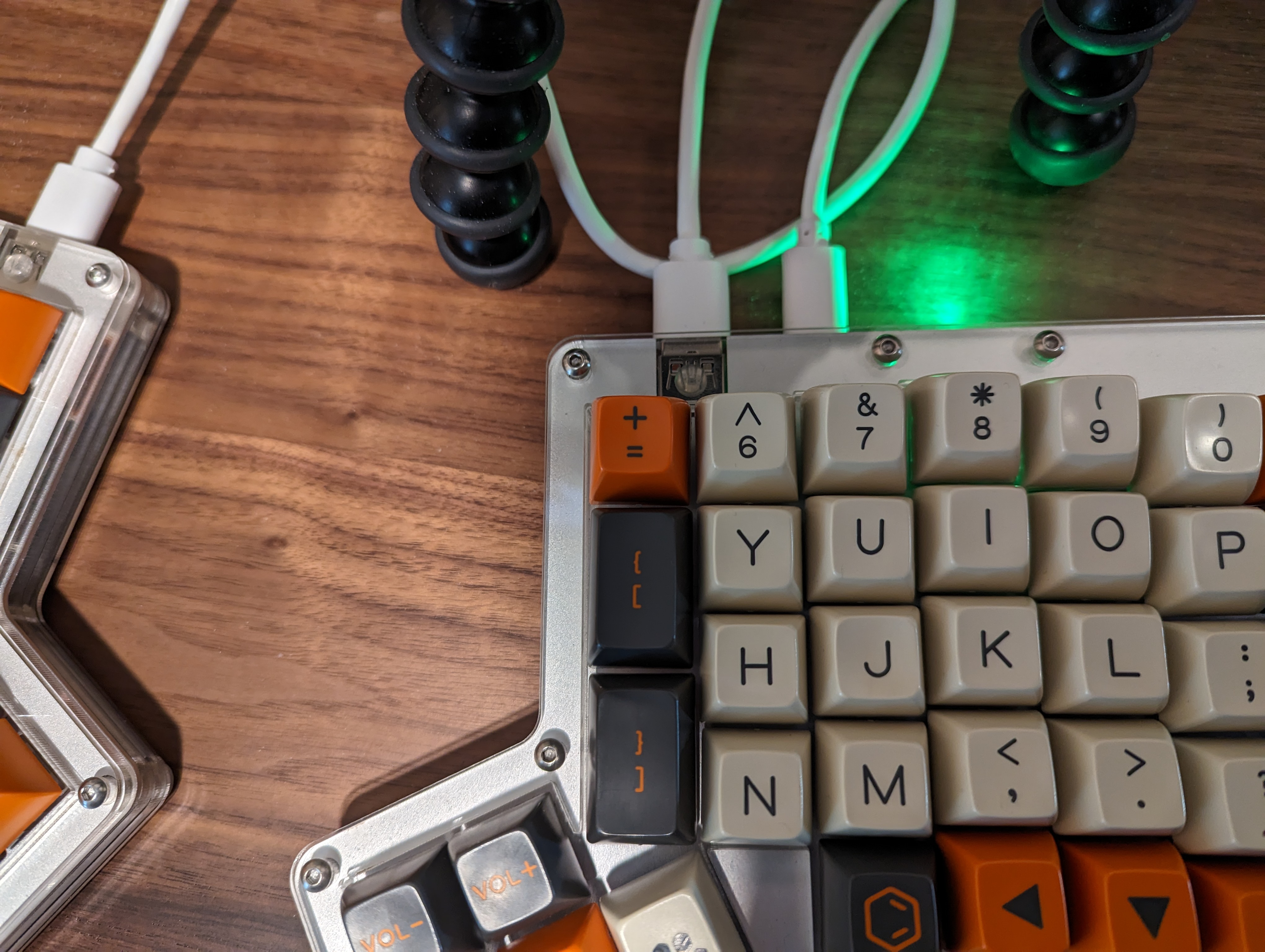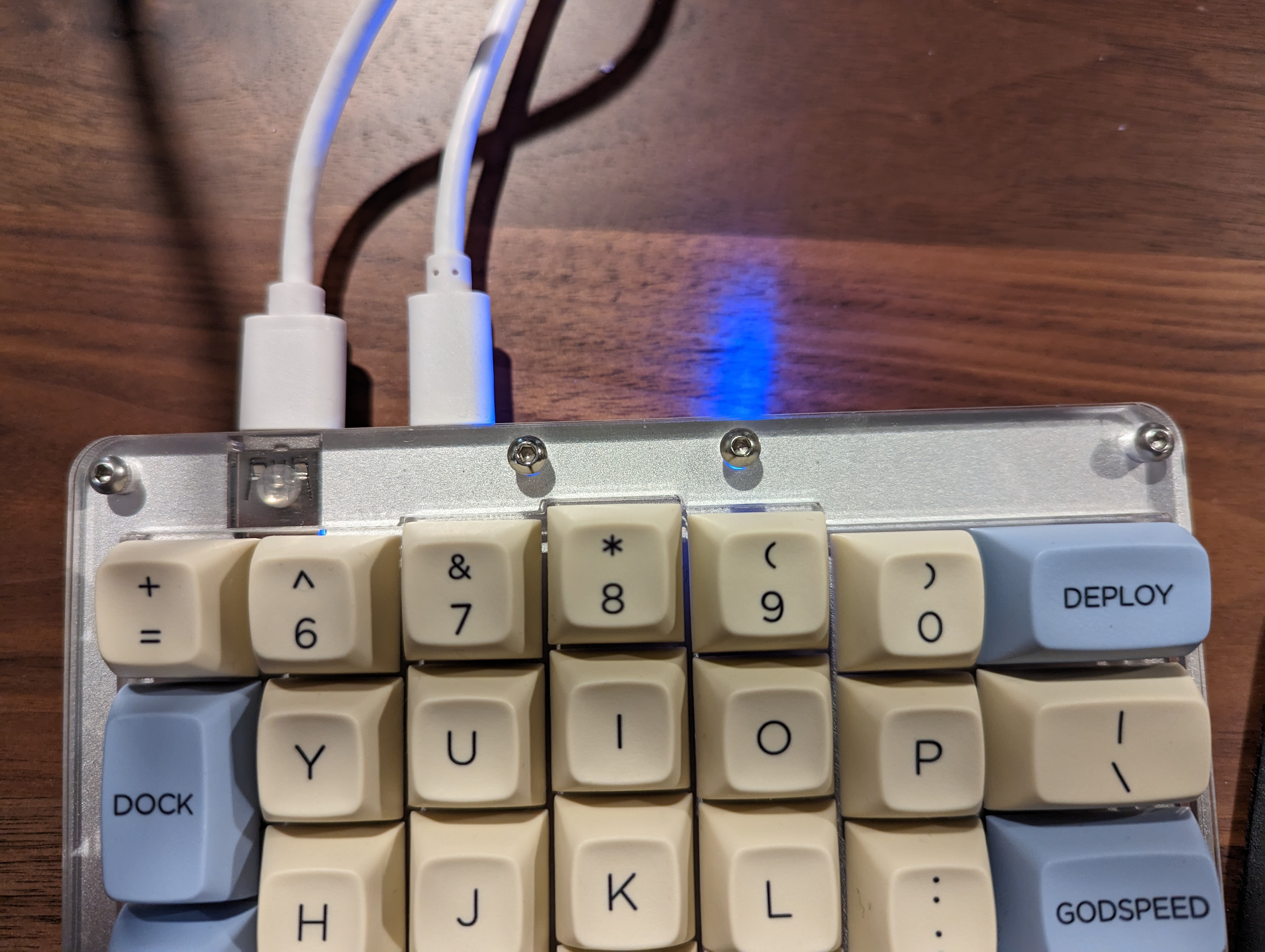Keyboard Waffle, part 3
LED check
First of all, how about those LEDs? As mentioned previously, the pads I could use for indicator LEDs were obscured by the switch plate. However you can still see the light if you know what to look for (which I do!):
And if I'm working in a dark room it's very obvious, with the light filtering out from various spots, e.g.:
All right. I can use those for mode indicators. Blue is the weakest so it gets to be the indicator for the mode that is least likely to be long-lived (which turned out to be "macro recording").
Configuration
Speaking of which, it's finally time to talk about configuration. The most generally interesting question to explore here is ... why? Lots of folks probably don't have a burning desire to change the way their keyboard behaves.
My goals were:
Have alphanumerics in the normal QWERTY keyboard spots.
Move shift and enter to thumbs instead of pinkies.
Shuffle modifier keys as necessary to make common combos comfortable. This needs to cover Windows, Linux, and macOS key combos that I use.
Support typing numbers and symbols using the main three rows (with modifiers), for reduced finger reach. This includes a standard numpad layout under the right hand.
Support typing arrow, enter, and space characters with the left hand (using modifiers) for when the right hand is on the mouse.
Include common 'media' keys, volume control, brightness, and screenlock.
Support recording and playback of short key sequences.
Support basic mouse cursor movement and button clicks.
Make it hard to hit 'dangerous' keys/combos by accident.
If you're actually interested to see a) the key layout and config that comes from those goals, and b) the specifics of how you would program the keyboard to do that, I'll just link to the main file of my config here. It's heavily commented and has some nifty ASCII art! It covers only the specifics of my personal configuration and doesn't get into any of the lower-level stuff common to all Hot Dox QMK firmware.
If you want to dig further into anything you see in that code, I recommend the QMK docs. Anything I'm using in my config should be findable in one of the sections "Simple Keycodes", "Advanced Keycodes", or "Software Features" there.
"Shooter mode"
So far none of that is particularly unusual for a custom keyboard config, but I did have one personal quirk I needed to take care of. Specifically, that my Quake key bindings were going to be unhappy with all this.
Back when Doom was released and the guys in my research lab started deathmatching, we didn't know about any conventions for setting up our key bindings. (Or at least I didn't.) The default bindings seemed self-evidently bad and the evolutionary pressures of office trash talk made me rethink those pretty quickly.
I started from first principles: I wanted each movement direction key under its own finger, plus spacebar for the "use" key (later of course for "jump" when QTest took over our lab). And I wanted a natural hand position that wouldn't give me RSI. If I rotated the keyboard a bit, I could get a nice comfy pose with left/right on the A and S keys, forward/backward on Shift and Ctrl, and spacebar too. So that was what I went with, for Doom and Quake and any similar FPS afterward.
Not too weird, right? Right?
Well. Even with different key bindings, that hand position just wasn't going to fly on the Ergodox layout. The key under the pinky wasn't a nice big key anymore, and the thumb key was pretty different too. I figured it was time to join the WASD world. I also needed to change the keyboard's behavior -- mostly, sacrificing special keys that wouldn't be useful anyway while gaming, and making them usable for game key binding. That's the "shooter mode" you'll see described in the config. I like it!
Verdict
You can probably tell that overall I'm happy with how things turned out. No complaints yet, really (knock on wood). Two thumbs up.
I'm pleased to get the SA Carbon keycaps back in action. The MT3 Godspeeds are fine but the colors and the slicker feel of the SA Carbons are more my thing.
Another issue with the Godspeeds BTW is that it was difficult to find appropriate keys for the thumb cluster and outer-column positions. The Carbon sets made an effort to have a lot of understandably-labelled keycaps available for the positions where they might be used, while on the other hand the philosophy of the Godspeed sets seems to mostly be: eh, if you have an unusual keyboard layout, you can just use keycaps that have "fun" words on them. So for example on the Carbon keyboard my volume control keys are labelled "Vol-" and "Vol+", while on the Godspeed keyboard they are "LWR" and "Fuel". I have keys marked "Tab" and "Control" on the Carbon keyboard, but for Godspeed I had to go with "Stage" and "Orbit". Etc.
(And for some of the mode-modifier keys I couldn't find anything I really liked at all in Godspeed. I ended up pirating some blank keys from Carbon since IMO that orange complements the Godspeed colors.)
It's not a usability issue for me since I'm super familiar with which-keys-are-where after doing so much work with the configuration. It just seems... overly cute? I dunno. It's fine. :-)
As for the switches, I'm enjoying the clicky ones a lot. Probably no way I could use these in an open-plan office though! It may just be novelty, since I spent so long on quieter switches before now? We'll see.
Of course the promise of hotswap boards is that you can try out different switches from time to time, but I can see now that's not a trivial operation. I mean, of course it's easier than desoldering everything, but the switch removal requires a bit of care and force. It's going to be quite a while before I'll be in the frame of mind where I want to yank all the keycaps and switches from one of these boards and then re-assemble it.
Thanks for reading! I think these particular project demons have been exorcised. I wonder what's next?


 Steamed Myth
Steamed Myth Apple on Deck
Apple on Deck Keyboard Waffle
Keyboard Waffle Clan 9 From Outer Space
Clan 9 From Outer Space PlanetQuake Interview
PlanetQuake Interview Custom Maps @ kitty1
Custom Maps @ kitty1 ClanRing Tourney 3 Demos
ClanRing Tourney 3 Demos










 ) except where indicated otherwise
) except where indicated otherwise